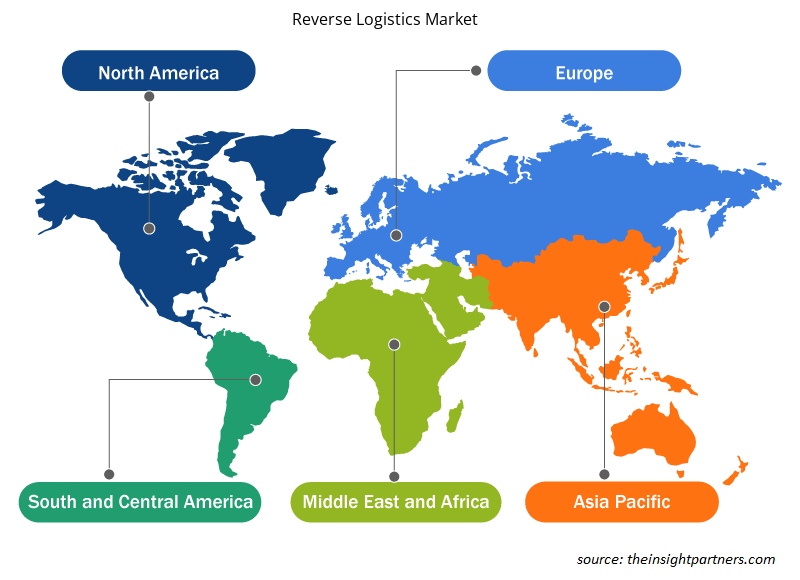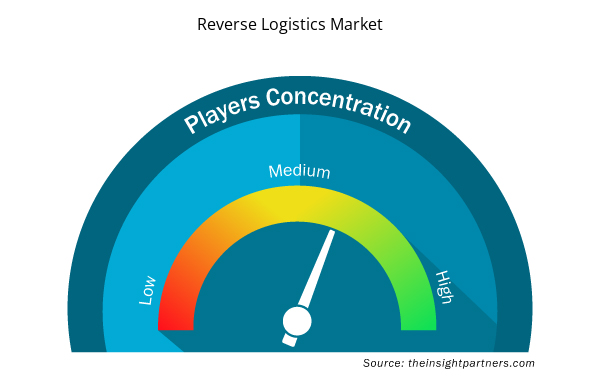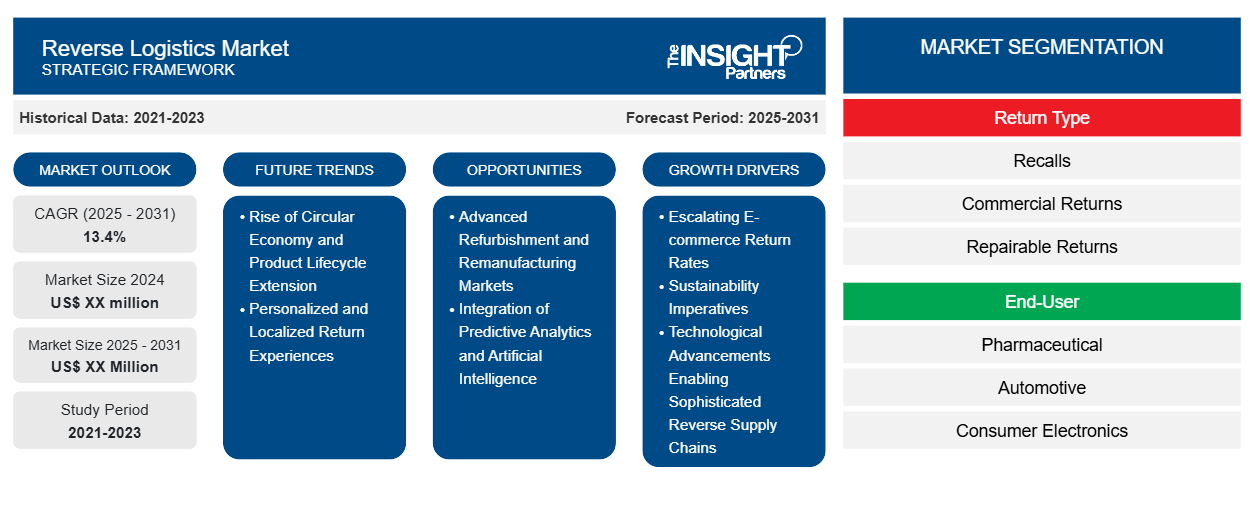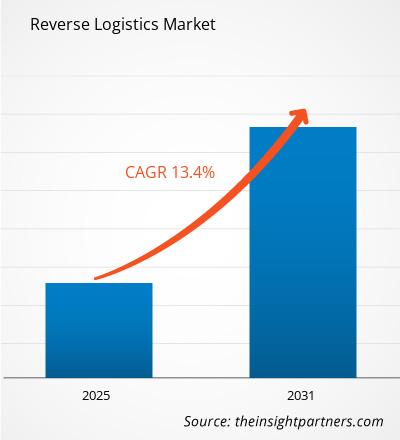من المتوقع أن يسجل سوق الخدمات اللوجستية العكسية معدل نمو سنوي مركب بنسبة 13.4٪ من عام 2023 إلى عام 2031، مع توسع حجم السوق من XX مليون دولار أمريكي في عام 2023 إلى XX مليون دولار أمريكي بحلول عام 2031.
تم تقسيم التقرير حسب نوع الإرجاع (الاستدعاءات، الإرجاعات التجارية، الإرجاعات القابلة للإصلاح، الإرجاعات في نهاية الاستخدام، الإرجاعات في نهاية العمر الافتراضي)؛ المستخدم النهائي (الأدوية، السيارات، الإلكترونيات الاستهلاكية، التجزئة، أخرى). تم تقسيم التحليل العالمي بشكل أكبر على المستوى الإقليمي والدول الرئيسية. يقدم التقرير القيمة بالدولار الأمريكي للتحليل والشرائح المذكورة أعلاه.
غرض التقرير
يهدف تقرير سوق الخدمات اللوجستية العكسية الصادر عن The Insight Partners إلى وصف المشهد الحالي والنمو المستقبلي وأهم العوامل الدافعة والتحديات والفرص. وسيوفر هذا رؤى لمختلف أصحاب المصلحة في الأعمال التجارية، مثل:
- مزودي/مصنعي التكنولوجيا: لفهم ديناميكيات السوق المتطورة ومعرفة فرص النمو المحتملة، وتمكينهم من اتخاذ قرارات استراتيجية مستنيرة.
- المستثمرون: إجراء تحليل شامل للاتجاهات فيما يتعلق بمعدل نمو السوق، وتوقعات السوق المالية، والفرص المتاحة عبر سلسلة القيمة.
- الهيئات التنظيمية: لتنظيم السياسات ومراقبة الأنشطة في السوق بهدف تقليل الانتهاكات والحفاظ على ثقة المستثمرين والحفاظ على سلامة السوق واستقرارها.
تجزئة سوق الخدمات اللوجستية العكسية
نوع الإرجاع
- الاستدعاءات
- الإرجاعات التجارية
- إرجاعات قابلة للإصلاح
- إرجاع المنتجات بعد انتهاء الاستخدام
- إرجاع نهاية العمر
المستخدم النهائي
- الصيدلة
- السيارات
- الالكترونيات الاستهلاكية
- بيع بالتجزئة
- آحرون
قم بتخصيص هذا التقرير ليناسب متطلباتك
ستحصل على تخصيص لأي تقرير - مجانًا - بما في ذلك أجزاء من هذا التقرير، أو تحليل على مستوى الدولة، وحزمة بيانات Excel، بالإضافة إلى الاستفادة من العروض والخصومات الرائعة للشركات الناشئة والجامعات
- احصل على أهم اتجاهات السوق الرئيسية لهذا التقرير.ستتضمن هذه العينة المجانية تحليلاً للبيانات، بدءًا من اتجاهات السوق وحتى التقديرات والتوقعات.
محركات نمو سوق الخدمات اللوجستية العكسية
- ارتفاع معدلات إرجاع المنتجات في التجارة الإلكترونية: أدى النمو الهائل للتسوق عبر الإنترنت إلى زيادة كبيرة في أحجام إرجاع المنتجات. ويتوقع المستهلكون الآن سياسات إرجاع سلسة وخالية من المتاعب، مما يدفع الشركات إلى تطوير بنية تحتية متطورة للوجستيات العكسية. ومع معدلات الإرجاع التي تتراوح بين 20-30% في التجارة الإلكترونية، مقارنة بنحو 8-10% في تجارة التجزئة التقليدية، فإن الشركات مضطرة إلى الاستثمار في أنظمة إدارة الإرجاع الفعالة. ويتطلب هذا الاتجاه تقنيات تتبع متقدمة وعمليات سلسلة توريد عكسية قوية وآليات استرداد أصول استراتيجية لتقليل الخسائر المالية وتعزيز رضا العملاء.
- الضرورات المستدامة: تدفع المخاوف البيئية ومبادئ الاقتصاد الدائري استثمارات كبيرة في مجال الخدمات اللوجستية العكسية. وتدرك الشركات الفوائد الاقتصادية والبيئية لإعادة تدوير المنتجات وتجديدها والتخلص منها بشكل مسؤول. وتفرض الضغوط التنظيمية، وخاصة في قطاعي الإلكترونيات والتغليف، استراتيجيات شاملة لإدارة النفايات. وتعمل المنظمات على تطوير أطر شاملة للخدمات اللوجستية العكسية لا تعمل على تقليل التأثير البيئي فحسب، بل تخلق أيضًا قيمة من خلال استعادة المواد وإعادة التصنيع والأسواق الثانوية، وتحويل ما كان يُعتبر في السابق نفايات إلى مصادر دخل محتملة.
- التطورات التكنولوجية التي تمكن سلاسل التوريد العكسية المتطورة: تعمل التقنيات الناشئة مثل الذكاء الاصطناعي والبلوك تشين والتحليلات المتقدمة على إحداث ثورة في قدرات الخدمات اللوجستية العكسية. تمكن هذه الابتكارات من التتبع في الوقت الفعلي والصيانة التنبؤية والتوجيه الذكي للمنتجات المرتجعة. تساعد خوارزميات التعلم الآلي الشركات على التنبؤ باحتمالات الإرجاع وتحسين عمليات التجديد واتخاذ قرارات قائمة على البيانات حول التخلص من المنتج. توفر أجهزة استشعار إنترنت الأشياء والمنصات الرقمية رؤية غير مسبوقة لتدفقات الإرجاع، مما يسمح للشركات بتبسيط العمليات وتقليل أوقات المعالجة واستخراج أقصى قيمة من البضائع المرتجعة.
الاتجاهات المستقبلية لسوق الخدمات اللوجستية العكسية
- صعود الاقتصاد الدائري وتمديد دورة حياة المنتج: يعمل مفهوم الاقتصاد الدائري على تحويل الخدمات اللوجستية العكسية من مركز تكلفة إلى آلية استراتيجية لخلق القيمة. تقوم الشركات بتصميم المنتجات مع مراعاة إمكانية إعادة التدوير والتفكيك السهل، مما يتيح استعادة المواد بكفاءة أكبر. تظهر نماذج الأعمال المبتكرة مثل المنتج كخدمة، حيث يحتفظ المصنعون بالملكية والمسؤولية عن دورات حياة المنتج. يشجع هذا الاتجاه على أنماط استهلاك أكثر استدامة، ويقلل من النفايات، ويخلق فرص إيرادات جديدة من خلال استراتيجيات التجديد وإعادة التصنيع واستصلاح المواد.
- تجارب الإرجاع المخصصة والمحلية: تدفع توقعات المستهلكين إلى التحول نحو تجارب إرجاع أكثر مرونة وراحة. وينفذ تجار التجزئة استراتيجيات إرجاع محلية للغاية، بما في ذلك التسليم داخل المتجر، والإرجاع على جانب الطريق، والشراكات مع مقدمي الخدمات اللوجستية من جهات خارجية. وتساعد التخصيصات المدعومة بالذكاء الاصطناعي الشركات على تصميم سياسات الإرجاع بناءً على سلوك العملاء الفرديين وخصائص المنتج وأنماط الإرجاع التاريخية. وتعمل هذه الأساليب المحلية على تقليل تكاليف النقل، والحد من التأثير البيئي، وتعزيز رضا العملاء بشكل عام من خلال توفير عمليات إرجاع أكثر ملاءمة وشخصية.
فرص سوق الخدمات اللوجستية العكسية
- أسواق التجديد وإعادة التصنيع المتقدمة: تقدم السوق المتنامية للمنتجات المستعملة والمجددة المعتمدة فرصًا كبيرة عبر قطاعات متعددة. تعمل صناعات الإلكترونيات والسيارات والمعدات الصناعية على تطوير عمليات تجديد متطورة تعيد المنتجات إلى حالتها الأصلية تقريبًا. تقدم هذه الأسواق بدائل أقل تكلفة للمنتجات الجديدة مع الحد من النفايات البيئية. يمكن لمقدمي الخدمات اللوجستية العكسية المتخصصين تطوير الخبرة في تقييم المنتجات وإصلاحها وإعادة تسويقها، مما يخلق نماذج أعمال مربحة تربط بين أهداف الاستدامة والأسواق الثانوية المربحة.
- دمج التحليلات التنبؤية والذكاء الاصطناعي: توفر تحليلات البيانات المتطورة وتقنيات الذكاء الاصطناعي فرصًا غير مسبوقة لتحسين عمليات الخدمات اللوجستية العكسية. يمكن للنماذج التنبؤية التنبؤ باحتمالات الإرجاع وتحديد مشكلات المنتج المحتملة قبل حدوثها والتوصية باستراتيجيات التصرف المثلى. يمكن لخوارزميات التعلم الآلي تحليل أنماط الإرجاع، مما يساعد الشركات على إعادة تصميم المنتجات وتحسين مراقبة الجودة وتطوير سياسات إرجاع أكثر فعالية. تمكن هذه التقنيات من إدارة المخزون بدقة أكبر، وتقليل تكاليف المعالجة، وتحويل الخدمات اللوجستية العكسية من وظيفة تجارية تفاعلية إلى وظيفة استباقية.
رؤى إقليمية حول سوق الخدمات اللوجستية العكسية
لقد قام المحللون في Insight Partners بشرح الاتجاهات والعوامل الإقليمية المؤثرة على سوق الخدمات اللوجستية العكسية طوال فترة التوقعات بشكل شامل. يناقش هذا القسم أيضًا قطاعات سوق الخدمات اللوجستية العكسية والجغرافيا في جميع أنحاء أمريكا الشمالية وأوروبا ومنطقة آسيا والمحيط الهادئ والشرق الأوسط وأفريقيا وأمريكا الجنوبية والوسطى.

- احصل على البيانات الإقليمية المحددة لسوق الخدمات اللوجستية العكسية
نطاق تقرير سوق الخدمات اللوجستية العكسية
| سمة التقرير | تفاصيل |
|---|---|
| حجم السوق في عام 2023 | XX مليون دولار أمريكي |
| حجم السوق بحلول عام 2031 | XX مليون دولار أمريكي |
| معدل النمو السنوي المركب العالمي (2023 - 2031) | 13.4% |
| البيانات التاريخية | 2021-2022 |
| فترة التنبؤ | 2024-2031 |
| القطاعات المغطاة | حسب نوع الإرجاع
|
| المناطق والدول المغطاة | أمريكا الشمالية
|
| قادة السوق وملفات تعريف الشركات الرئيسية |
|
كثافة اللاعبين في سوق الخدمات اللوجستية العكسية: فهم تأثيرها على ديناميكيات الأعمال
يشهد سوق الخدمات اللوجستية العكسية نموًا سريعًا، مدفوعًا بالطلب المتزايد من المستخدم النهائي بسبب عوامل مثل تفضيلات المستهلكين المتطورة والتقدم التكنولوجي والوعي المتزايد بفوائد المنتج. ومع ارتفاع الطلب، تعمل الشركات على توسيع عروضها والابتكار لتلبية احتياجات المستهلكين والاستفادة من الاتجاهات الناشئة، مما يؤدي إلى زيادة نمو السوق.
تشير كثافة اللاعبين في السوق إلى توزيع الشركات أو المؤسسات العاملة في سوق أو صناعة معينة. وهي تشير إلى عدد المنافسين (اللاعبين في السوق) الموجودين في مساحة سوق معينة نسبة إلى حجمها أو قيمتها السوقية الإجمالية.
الشركات الرئيسية العاملة في سوق الخدمات اللوجستية العكسية هي:
- شركة سي اتش روبنسون العالمية
- شركة كور لوجيستك الخاصة المحدودة
- دي بي شينكر
- شركة دي إتش إل العالمية المحدودة
- شركة فيديكس
إخلاء المسؤولية : الشركات المذكورة أعلاه ليست مرتبة بأي ترتيب معين.

- احصل على نظرة عامة على أهم اللاعبين الرئيسيين في سوق الخدمات اللوجستية العكسية
نقاط البيع الرئيسية
- التغطية الشاملة: يغطي التقرير بشكل شامل تحليل المنتجات والخدمات والأنواع والمستخدمين النهائيين لسوق الخدمات اللوجستية العكسية، مما يوفر صورة شاملة.
- تحليل الخبراء: تم تجميع التقرير على أساس الفهم العميق لخبراء الصناعة والمحللين.
- معلومات محدثة: يضمن التقرير أهمية الأعمال التجارية بسبب تغطيته للمعلومات الحديثة واتجاهات البيانات.
- خيارات التخصيص: يمكن تخصيص هذا التقرير لتلبية متطلبات العملاء المحددة وبما يتناسب مع استراتيجيات العمل بشكل مناسب.
وبالتالي، يمكن أن يساعد تقرير البحث حول سوق الخدمات اللوجستية العكسية في تمهيد الطريق لفك شفرة وفهم سيناريو الصناعة وآفاق النمو. ورغم وجود بعض المخاوف المشروعة، فإن الفوائد الإجمالية لهذا التقرير تميل إلى التفوق على العيوب.
- التحليل التاريخي (سنتان)، السنة الأساسية، التوقعات (7 سنوات) مع معدل النمو السنوي المركب
- تحليل PEST و SWOT
- حجم السوق والقيمة / الحجم - عالميًا وإقليميًا وقطريًا
- الصناعة والمنافسة
- مجموعة بيانات Excel


- Artificial Turf Market
- Sodium Bicarbonate Market
- Redistribution Layer Material Market
- Intraoperative Neuromonitoring Market
- Foot Orthotic Insoles Market
- Adaptive Traffic Control System Market
- Point of Care Diagnostics Market
- Europe Surety Market
- Batter and Breader Premixes Market
- Industrial Valves Market

Report Coverage
Revenue forecast, Company Analysis, Industry landscape, Growth factors, and Trends

Segment Covered
This text is related
to segments covered.

Regional Scope
North America, Europe, Asia Pacific, Middle East & Africa, South & Central America

Country Scope
This text is related
to country scope.
الأسئلة الشائعة
Some of the customization options available based on the request are an additional 3-5 company profiles and country-specific analysis of 3-5 countries of your choice. Customizations are to be requested/discussed before making final order confirmation, as our team would review the same and check the feasibility.
The report can be delivered in PDF/PPT format; we can also share excel dataset based on the request.
The leading players operating in the Reverse Logistics Market include C H Robinson Worldwide Inc, Core Logistic Private Limited, DB SCHENKER, DHL International GmbH, FedEx Corporation, Kuehne Nagel International AG, Safexpress Pvt Ltd, United Parcel Service of America Inc, and YUSEN LOGISTICS CO LTD
The Reverse Logistics Market is estimated to witness a CAGR of 13.4% from 2023 to 2031
Changing customer preference is the key future trend of the Reverse Logistics Market
The major factors driving the Reverse Logistics Market are: Advent of Advanced Technology such as Automation, Blockchain, and other
Trends and growth analysis reports related to Automotive and Transportation : READ MORE..
1. C.H. Robinson Worldwide, Inc.
2. Core Logistic Private Limited
3. DB SCHENKER
4. DHL International GmbH
5. FedEx Corporation
6. Kuehne + Nagel International AG
7. Safexpress Pvt. Ltd.
8. United Parcel Service of America, Inc
9. YUSEN LOGISTICS CO, LTD
10. Zebra Technologies Corp
The Insight Partners performs research in 4 major stages: Data Collection & Secondary Research, Primary Research, Data Analysis and Data Triangulation & Final Review.
- Data Collection and Secondary Research:
As a market research and consulting firm operating from a decade, we have published and advised several client across the globe. First step for any study will start with an assessment of currently available data and insights from existing reports. Further, historical and current market information is collected from Investor Presentations, Annual Reports, SEC Filings, etc., and other information related to company’s performance and market positioning are gathered from Paid Databases (Factiva, Hoovers, and Reuters) and various other publications available in public domain.
Several associations trade associates, technical forums, institutes, societies and organization are accessed to gain technical as well as market related insights through their publications such as research papers, blogs and press releases related to the studies are referred to get cues about the market. Further, white papers, journals, magazines, and other news articles published in last 3 years are scrutinized and analyzed to understand the current market trends.
- Primary Research:
The primarily interview analysis comprise of data obtained from industry participants interview and answers to survey questions gathered by in-house primary team.
For primary research, interviews are conducted with industry experts/CEOs/Marketing Managers/VPs/Subject Matter Experts from both demand and supply side to get a 360-degree view of the market. The primary team conducts several interviews based on the complexity of the markets to understand the various market trends and dynamics which makes research more credible and precise.
A typical research interview fulfils the following functions:
- Provides first-hand information on the market size, market trends, growth trends, competitive landscape, and outlook
- Validates and strengthens in-house secondary research findings
- Develops the analysis team’s expertise and market understanding
Primary research involves email interactions and telephone interviews for each market, category, segment, and sub-segment across geographies. The participants who typically take part in such a process include, but are not limited to:
- Industry participants: VPs, business development managers, market intelligence managers and national sales managers
- Outside experts: Valuation experts, research analysts and key opinion leaders specializing in the electronics and semiconductor industry.
Below is the breakup of our primary respondents by company, designation, and region:

Once we receive the confirmation from primary research sources or primary respondents, we finalize the base year market estimation and forecast the data as per the macroeconomic and microeconomic factors assessed during data collection.
- Data Analysis:
Once data is validated through both secondary as well as primary respondents, we finalize the market estimations by hypothesis formulation and factor analysis at regional and country level.
- Macro-Economic Factor Analysis:
We analyse macroeconomic indicators such the gross domestic product (GDP), increase in the demand for goods and services across industries, technological advancement, regional economic growth, governmental policies, the influence of COVID-19, PEST analysis, and other aspects. This analysis aids in setting benchmarks for various nations/regions and approximating market splits. Additionally, the general trend of the aforementioned components aid in determining the market's development possibilities.
- Country Level Data:
Various factors that are especially aligned to the country are taken into account to determine the market size for a certain area and country, including the presence of vendors, such as headquarters and offices, the country's GDP, demand patterns, and industry growth. To comprehend the market dynamics for the nation, a number of growth variables, inhibitors, application areas, and current market trends are researched. The aforementioned elements aid in determining the country's overall market's growth potential.
- Company Profile:
The “Table of Contents” is formulated by listing and analyzing more than 25 - 30 companies operating in the market ecosystem across geographies. However, we profile only 10 companies as a standard practice in our syndicate reports. These 10 companies comprise leading, emerging, and regional players. Nonetheless, our analysis is not restricted to the 10 listed companies, we also analyze other companies present in the market to develop a holistic view and understand the prevailing trends. The “Company Profiles” section in the report covers key facts, business description, products & services, financial information, SWOT analysis, and key developments. The financial information presented is extracted from the annual reports and official documents of the publicly listed companies. Upon collecting the information for the sections of respective companies, we verify them via various primary sources and then compile the data in respective company profiles. The company level information helps us in deriving the base number as well as in forecasting the market size.
- Developing Base Number:
Aggregation of sales statistics (2020-2022) and macro-economic factor, and other secondary and primary research insights are utilized to arrive at base number and related market shares for 2022. The data gaps are identified in this step and relevant market data is analyzed, collected from paid primary interviews or databases. On finalizing the base year market size, forecasts are developed on the basis of macro-economic, industry and market growth factors and company level analysis.
- Data Triangulation and Final Review:
The market findings and base year market size calculations are validated from supply as well as demand side. Demand side validations are based on macro-economic factor analysis and benchmarks for respective regions and countries. In case of supply side validations, revenues of major companies are estimated (in case not available) based on industry benchmark, approximate number of employees, product portfolio, and primary interviews revenues are gathered. Further revenue from target product/service segment is assessed to avoid overshooting of market statistics. In case of heavy deviations between supply and demand side values, all thes steps are repeated to achieve synchronization.
We follow an iterative model, wherein we share our research findings with Subject Matter Experts (SME’s) and Key Opinion Leaders (KOLs) until consensus view of the market is not formulated – this model negates any drastic deviation in the opinions of experts. Only validated and universally acceptable research findings are quoted in our reports.
We have important check points that we use to validate our research findings – which we call – data triangulation, where we validate the information, we generate from secondary sources with primary interviews and then we re-validate with our internal data bases and Subject matter experts. This comprehensive model enables us to deliver high quality, reliable data in shortest possible time.


 احصل على عينة مجانية لهذا التقرير
احصل على عينة مجانية لهذا التقرير